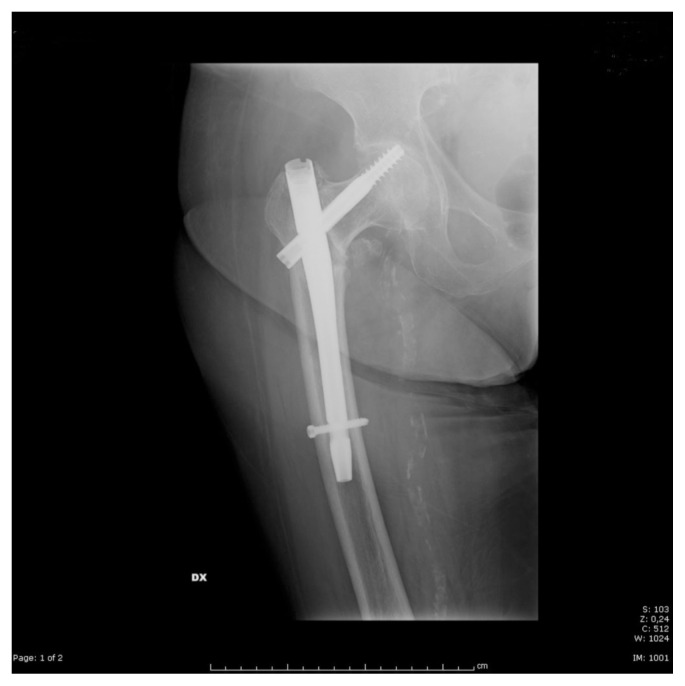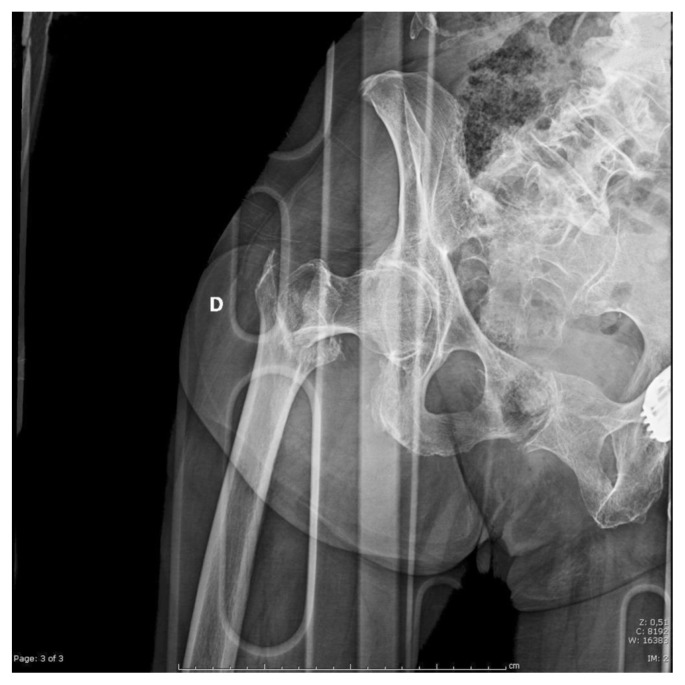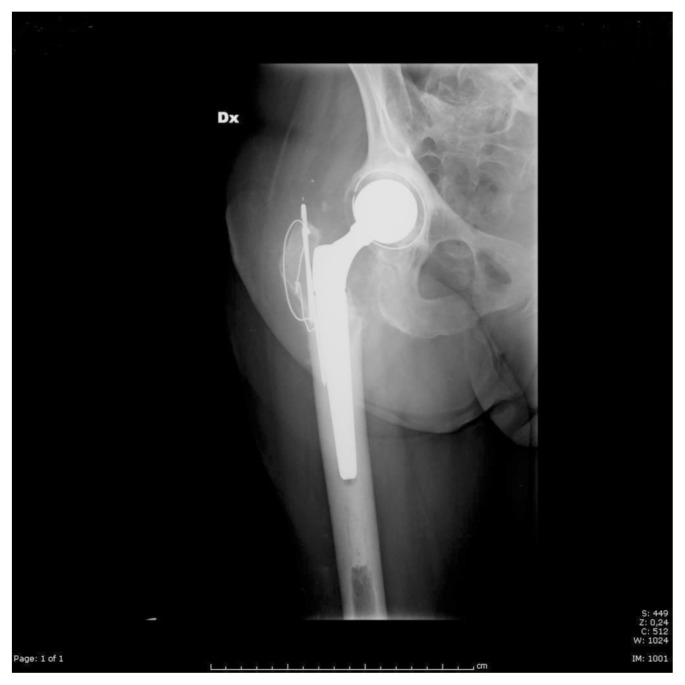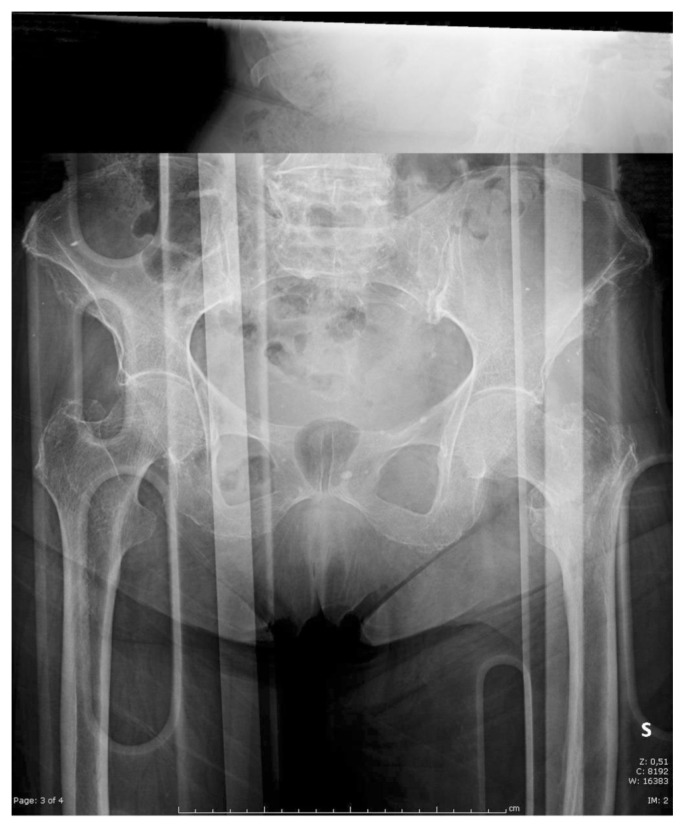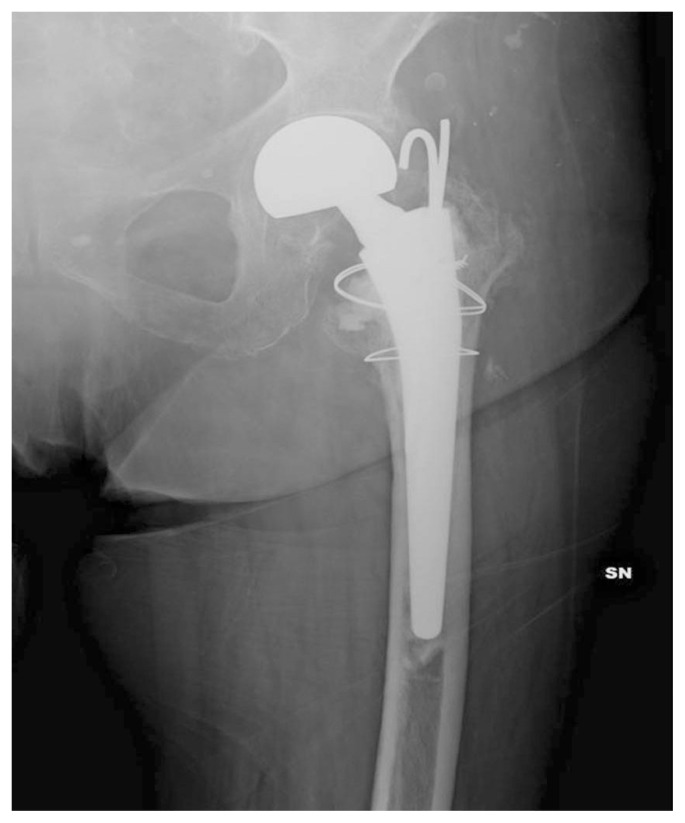Summary
The third proximal femur fractures are divided into medial and lateral ones. For medial fractures already exists unanimity of thought for the choice of treatment that involves the prosthetic replacement of the hip joint in patients over 60 without indications to the synthesis. Regarding the lateral femur fractures this unanimity does not exist yet even if the majority of surgeons practice treatment with osteosynthesis. We want to highlight if there are any types of lateral fractures associated with patient’s clinical condition in which it might be more useful to a prosthetic replacement with the aim of being able to allow a total load and earlier deambulation, reducing complications related to a possible patient immobilization.
Keywords: lateral femoral fracture, hip replacement, earlier deambulation
Introduction
At present time proximal femoral fractures account for 30% of all fractures referred to hospitals for treatment. The population is ageing, the proportion of patients with postmenopausal or senile osteoporosis is increasing and therefore the number of proximal femoral fractures requiring urgent treatment is growing accordingly.
In the age category of 50 years and older, the incidence of these fractures has increased exponentially.
Dousa shows that over 4280 patients, 3112 women and 1168 men, admitted to the department for treatment of proximal femoral fractures, 54.7% were a trochanteric fractures while 45.3% were femoral neck fractures. The inter-annual increase was 5.9%, with more trochanteric than femoral neck fractures.
Pertrochanteric fractures occurred more frequently (81.5%); the patients’ age was higher (80 years on average) and women outnumbered men at a ratio of 3:1. Intertrochanteric fractures were found in significantly younger patients (average, 72 years), with a women-to-men ratio of 1.3:1 (1, 2).
Due to the high percentage of lateral femural fractures it is necessary to standardize as much as possible, as already has been done in the past for the medial femural fractures, the most appropriate treatment. The standard treatment, commonly accepted, is osteosynthesis. Its objective is to have a stable synthesis, mobilization and a total load as early as possible.
The indication for prosthetic replacement in this type of fractures already exists in the literature as rescue intervention in failed osteosynthesis.
Hip arthroplasty may have a primary indication in the lateral femur fractures?
To answer this question we must consider the type of fracture and especially the possibility to classify the fracture stable or unstable. This can change the therapeutic approach to surgery. The main classifications that allow us to determine whether a fracture can be considered stable or not are two: AO/ASIF classification and Evans classification.
31-A1 type of fractures or pertrochanteric simple according to the AO classification and type I and II according to Evans classifications are considered stable.
This type of fractures already have an absolute indication osteosynthesis, that is accepted by all surgeons.
The objective of any surgical care of a trochanteric femoral fracture should be the achievement of a stable osteosynthesis that allows early full weight-bearing mobilisation of the patient, because long-term immobilisation soon becomes a vital threat to the affected patients who are usually elderly with correlating comorbidities.
So uncomplex trochanteric fractures ordinarily stabilise sufficiently after reposition so that even an extramedullary implant can ensure full weight-bearing stability.
However a primary total hip arthroplasty is a potential option for surgical care of a trochanteric fracture in elderly patients with relevant coxarthrosis. This procedure can only be recommended in cases of a stable uncomplex fracture (3).
The AO/ASIF considers unstable fractures the multyfragmentary pertrochanteric fractures or 31-A2 and the intertrochanteric ones or A3–31 type, while the Evans classification, which assesses the lack of medial and posterolateral support, or both, considers unstable fractures the III, IV and V types.
The treatment of unstable intertrochanteric fractures in the elderly patient is still controversial because often this type of fractures are comminuted, patients are elderly with marked osteoporosis (4).
With these conditions it is very difficult to obtain a stable synthesis and a good reduction of the fracture (Figure 1). There is a study that points out that 56% of the fixations made under these conditions fail (5).
Figure 1.
Femoral cut out after synthesis in 86-year-old woman.
For these reasons some authors, recently, advocated the use of cemented bipolar arthroplasty or hemiarthroplasty which results in better functional outcome.
Sinno et al. did a study about one hundred and two patients admitted to Makassed General Hospital between 2002 and 2007 with a diagnosis of unstable intertrochanteric fracture of femur. They used Harris Hip score and the main clinical measures were early postoperative full weight bearing, postoperative complications and functional outcome. The Authors, according to their results, believed that cemented bipolar hemiarthroplasty was of choice in freely mobile elderly patients above seventy with an intertrochanteric femoral fracture (6).
Already in the 70s some authors have studied this issue and there were, later, numerous studies comparing the synthesis and prosthetic replacement in the lateral fractures (7).
Rosenfeld, in the 70s, proposed hip replacement surgery as the first surgical choice in the trochanteric femural fractures (7). In the 1989 Haentjens et al. compared the treatment of unstable intertrochanteric and subtrochanteric fractures in elderly patients with primary bipolar arthroplasty or with internal fixation. They compared two groups of patients: the first group 37 patients who had unstable intertrochanteric or subtrochanteric fracture were treated by primary bipolar arthroplasty from 1983 through 1986; the second group which was a retrospective control group of 42 patients who were treated by internal fixation from 1979 through 1982. In the bipolar arthroplasty group, rehabilitation was easier and faster, and the incidences of pressure sores, pulmonary infection, and atelectasis were significantly lower. The early walking with full weight-bearing, that the bipolar arthroplasty made possible, is considered to be a major contributing factor to these results (8).
Random controlled trials made at Stockholm Soder Hospital, done at two years postoperatively have shown that a primary total hip replacement is superior to internal fixation for the treatment of a displaced femoral neck fracture in a relatively healthy, mentally competent, elderly patient. In this study the Authors showed that at the forty-eight-month follow-up evaluation, the rate of hip complications was 4% in the patients treated with total hip replacement and 42% in those treated with internal fixation (p < 0.001) and the reoperation rates were 4% and 47%, respectively (p < 0.001). The arthroplasty group had no additional hip complications or reoperations between the twenty-four and forty-eight-month follow-up visits. In the fixation group, the percentage of hip complications increased from 36 to 42% and the percentage of reoperations increased from 42 to 47% during the same period. The hip function was significantly better and the decline in health-related quality of life was less pronounced in the arthroplasty group than it was in the fixation group at the four, twelve, and twenty-four-month follow-up evaluations (9).
The influence of some risk factors could be reduced by new techniques and new materials but age, sex and morbidity influenced the outcome more than surgical treatment. Total hip replacement, even after pertrochanteric fractures, is reasonable if it guarantees a quick and enduring mobilisation of the patient. Bicentric bipolar prostheses are recommended for high risk patients (10).
Our experience with Prof. Faldini et al. in 2002, is, as first choice, surgical hip arthoplasty in the lateral femoral unstable fractures in elderly and osteoporotic patients. He treated with total hip arthroplasty 52 patients with these kind of fracture. After a year, 43 of these patients were alive and autonomous, reporting a mortality rate of 17.3%. They reported no intraoperative complications, no episode of dislocation of the implant, no cases of infection or mobilization of the prosthesis; 16 patients had a lengthening of the operated limb of 0.5–1.5 cm, 2 patients died of PE, 7 patients died one year after the fracture and as many as 24 patients alive at 5 years of follow-up after the fracture (11).
Surgical technique
Implanting prosthesis in unstable lateral fractures of the femur everyone is faced with relevant steps to reach the best outcome for the implant. First of all you have to manage the medial wall: the necessity of restoring continuity in the medial cortex of the femoral neck (Adams’ arch) is the requirement that should be observed (1).
The reconstruction of the medial wall, which can be done through cerclages, cable ready, or by other techniques, is essential to give the correct version and the correct height of the system. Even the particular prosthetic design can facilitate the reconstruction of the medial wall.
Bipolar hemiarthroplasty with calcar reconstruction is a good option for unstable intertrochanteric fractures in elderly patients with severe osteoporosis with strict indication selection (12).
Prosthetic replacement with reconstruction of the calcar is considered an excellent choice for unstable and osteoporotic fractures on condition that patients are carefully selected from the anesthesiological point of view. The prosthetic approach in fact always requires a longer surgical time, a higher loss of blood and increased invasiveness compared to an osteosynthesis.
The other fundamental point to consider is the management of the lateral wall which is the synthesis of the greater trochanter. This is necessary to ensure stability to the system, to successfully restore the center of rotation and for a correct deambulatory functionality. The fixation can be performed with the use of wires and cerclage, or through the use of dedicated plates (Figures 2a, b).
Figure 2a.
Pre-operative X-ray of a lateral femoral fracture in 81-year-old woman.
Figure 2b.
Post operative X-ray.
Once managed the problems of reconstruction of the medial calcar and the synthesis of the greater trochanter, the aim is to find out which kind of prosthesis implants can lead to the best clinical and functional outcomes. Some authors advocated the use of cemented bipolar arthroplasty or hemiarthroplasty which results in better functional outcome. According to their results, they believe that cemented bipolar hemiarthroplasty is of choice in freely mobile elderly patients above seventy years of age with an intertrochanteric femoral fracture. The time to full weight bearing, the rate of postoperative complications, and the functional outcomes was significantly better in the cemented bipolar arthroplasty group (7).
Primary total hip replacement should be handled with care due to its significantly higher dislocation rate compared with hemiarthroplasty especially in unstable fractures. The mortality risk of primary cemented arthroplasty did not differ significantly from the treatment with dynamic hip screw (DHS) or with a short proximal femoral nail (PFN) and because of its low complication rate it is a viable treatment option for trochanteric fractures if osteoporosis prevents from full weight bearing or if osteoarthritis makes further operations likely (13).
Bipolar hemiarthroplasty for unstable intertrochanteric fractures in elderly patients is a viable option that can prevent the complications of an open reduction, such as nonunion and metal failure. The short-term results of cementless bipolar hemiarthroplasty in forty hips of elderly patients with unstable intertrochanteric fractures were satisfactory because 60% of patients showed no decrease in ambulation capacity post operatively, only one case of hip pain and one case of thigh pain. Radiologically 57.5% of fixation by bone ingrowth and 42.5% of stable fibrous fixation. No cases of osteolysis (14).
According to Lee et al. cementless bipolar hemiarthroplasty using an extensively hydroxyapatite-coated long stem is a useful option for the treatment of unstable intertrochanteric fracture in senile patients with severe osteoporosis. They evaluated the results of 87 cementless bipolar hemiarthroplasties using an extensively hydroxyapatite-coated long stem for unstable intertrochanteric fractures in senile patients, 61 of these cases were followed for a minimum of 2 years postoperatively: two hips were reoperated because of infection and of the remaining 59 hips, 48 were included in the radiographic analysis. Although cortical porosis around the stem was seen in 18 hips, there was no loosening or osteolysis (15).
Replacement of the hip using arthroplasty, often used for intracapsular fractures, has been used as an alternative of internal fixation, commonly used for extracapsular hip fractures, that may fail particularly in unstable fractures (Figures 3a, b). The main difference from internal fixation was a higher blood transfusion need in the arthroplasty group (16).
Figure 3a.
Pre operative X-ray of lateral femoral fracture in 93-year-old woman.
Figure 3b.
Post operative X-ray of lateral femoral fracture after medial and lateral wall reconstruction in 93-year-old woman.
Conclusion
In the treatment of unstable lateral fractures of the femur in elderly and osteoporotic patients, there are no major differences between hemiarthroplasty or total hip prosthesis, between cemented or uncemented prosthesis, but there are significant differences between fixation versus arthroplasty.
Although the majority of intertrochanteric fractures can be successfully managed with operative reduction and fixation, some patients may benefit from prosthetic replacement.
For older patients with severe osteoporosis or comminution there are some definite advantages of prosthetic replacement over reduction and fixation.
Prosthetic replacement surgery is surely a more difficult with longer operative times, but there are no significant differences between the two interventions for mechanical complications, local wound complications, reoperation, general complications and mortality at one year or long-term function (16).
The prosthetic replacement has very little concern over immediate ambulation and weight-bearing. This decreases the incidence of postoperative complications, such as pulmonary infection, atelectasis, and pressure sores. In addition, acute prosthetic replacement eliminates the possibility of excessive collapse compromising walking function, mal-union, as well as the uncommon problems of non-union and avascular necrosis (17–19).
In conclusion, in agreement with other authors, we believe that the replacement prosthesis can then be made as the first surgical choice in 2 different groups: first, in lateral stable fractures with hip joint arthrosis, second in unstable fractures in elderly patients, with osteoporosis, comminuted fractures anaesthesiological selected.
ASA classification can help to identify the impact of hip surgery in high-risk patients.
However, in the Literature there is insufficient evidence from random trials to determine whether replacement arthroplasty has any advantage over internal fixation for extracapsular hip fractures. Further larger well-designed random trials comparing arthroplasty versus internal fixation for the treatment of unstable fractures are required (16).
There are few comparative studies and even fewer prospective, random controlled trials which have compared prosthetic replacement surgery with standard internal fixation techniques in the long run. Many studies have been small case series without a control group.
Overall, rigorously conducted prospective random clinical trials with long-term follow-up are lacking (20).
Footnotes
Disclosure
No benefits or funds were received in support of this study.
None of the Authors has any conflict of interests to disclose.
References
- 1.Douša P, Čech O, Weissinger M, Džupa V. Trochanteric femoral fractures. Acta Chir Orthop Traumatol Cech. 2013;80(1):15–26. [PubMed] [Google Scholar]
- 2.Piscitelli P, Feola M, Rao C, Celi M, Gasbarra E, Neglia C, Quarta G, Liuni FM, Parri S, Iolascon G, Brandi ML, Distante A, Tarantino U. Ten years of hip fractures in Italy: For the first time a decreasing trend in elderly women. World J Orthop. 2014 Jul 18;5(3):386–91. doi: 10.5312/wjo.v5.i3.386. [DOI] [PMC free article] [PubMed] [Google Scholar]
- 3.Bonnaire F, Lein T, Bula P. Trochanteric femoral fractures: anatomy, biomechanics and choice of implants. Unfallchirurg. 2011 Jun;114(6):491–500. doi: 10.1007/s00113-011-1973-2. [DOI] [PubMed] [Google Scholar]
- 4.Giannotti S, Bottai V, Pini E, Dell’osso G, De Paola G, Guido G. Clinical and surgical approach of severe bone fragility fracture: clinical case of 4 fragility fracture in patient with heavy osteoporosis. Clin Cases Miner Bone Metab. 2013 Jan;10(1):52–5. doi: 10.11138/ccmbm/2013.10.1.052. [DOI] [PMC free article] [PubMed] [Google Scholar]
- 5.Sinno Khaldoun, Sakr Mazen, Girard Julien, Khatib Hassan. The effectiveness of primary bipolar arthroplasty in treatment of unstable intertrochanteric fractures in elderly patients. N Am J Med Sci. 2010 Dec;2(12):561–568. doi: 10.4297/najms.2010.2561. [DOI] [PMC free article] [PubMed] [Google Scholar]
- 6.Sinno K, Sakr M, Girard J, Khatib H. The effectiveness of primary bipolar arthroplasty in treatment of unstable intertrochanteric fractures in elderly patients. N Am J Med Sci. 2010 Dec;2(12):561–8. doi: 10.4297/najms.2010.2561. [DOI] [PMC free article] [PubMed] [Google Scholar]
- 7.Rosenfeld R, et al. Prosthetic replacement for throcanteric fractures of the Femur. J Bone Joint Surg. 1973 [Google Scholar]
- 8.Haentjens P, Casteleyn PP, De Boeck H, Handelberg F, Opdecam P. Treatment of unstable intertrochanteric and subtrochanteric fractures in elderly patients. Primary bipolar arthroplasty compared with internal fixation. J Bone Joint Surg Am. 1989 Sep;71(8):1214–25. [PubMed] [Google Scholar]
- 9.Blomfeldt R, Törnkvist H, Ponzer S, Söderqvist A, Tidermark J. Comparison of internal fixation with total hip replacement for displaced femoral neck fractures. Randomized, controlled trial performed at four years. J Bone Joint Surg Am. 2005 Aug;87(8):1680–8. doi: 10.2106/JBJS.D.02655. [DOI] [PubMed] [Google Scholar]
- 10.Geiger F, Schreiner K, Schneider S, Pauschert R, Thomsen M. Proximal fracture of the femur in elderly patients. The influence of surgical care and patient characteristics on post-operative mortality. Orthopade. 2006 Jun;35(6):651–7. doi: 10.1007/s00132-006-0930-1. [DOI] [PubMed] [Google Scholar]
- 11.Faldini A, Betti E, Crimaldi S, Raffaetà G, Faldini C. Surgical treatment of interthrocanteric fractures by total hip arthroplasty in old, osteoporotic patients. Scientific Exhibit At 69th AAOS annual Meeting; 2002. pp. 12–19. [Google Scholar]
- 12.Abdelkhalek M, Ali AM, Abdelwahab M. Cemented bipolar hemiarthroplasty with a cerclage cable technique for unstable intertrochanteric hip fractures in elderly patients. Eur J Orthop Surg Traumatol. 2013 May;23(4):443–8. doi: 10.1007/s00590-012-1006-z. [DOI] [PubMed] [Google Scholar]
- 13.Geiger F, Zimmermann-Stenzel M, Heisel C, Lehner B, Daecke W. Trochanteric fractures in the elderly: the influence of primary hip arthroplasty on 1-year mortality. Arch Orthop Trauma Surg. 2007 Dec;127(10):959–66. doi: 10.1007/s00402-007-0423-7. [DOI] [PMC free article] [PubMed] [Google Scholar]
- 14.Choy WS, Ahn JH, Ko JH, Kam BS, Lee DH. Cementless bipolar hemiarthroplasty for unstable intertrochanteric fractures in elderly patients. Clin Orthop Surg. 2010 Dec;2(4):221–6. doi: 10.4055/cios.2010.2.4.221. [DOI] [PMC free article] [PubMed] [Google Scholar]
- 15.Lee YK, Ha YC, Chang BK, Kim KC, Kim TY, Koo KH. Cementless bipolar hemiarthroplasty using a hydroxyapatite-coated long stem for osteoporotic unstable intertrochanteric fractures. J Arthroplasty. 2011 Jun;26(4):626–32. doi: 10.1016/j.arth.2010.05.010. [DOI] [PubMed] [Google Scholar]
- 16.Parker MJ, Handoll HH. Replacement arthroplasty versus internal fixation for extracapsular hip fractures in adults. Cochrane Database Syst Rev. 2006 Apr 19;(2):CD000086. doi: 10.1002/14651858.CD000086.pub2. [DOI] [PMC free article] [PubMed] [Google Scholar]
- 17.Bottai V, Giannotti S, Dell’Osso G, De Paola G, Menconi A, Falossi F, Raffaetà G, Guido G. Atypical femoral fractures: retrospective radiological study of 319 femoral fractures and presentation of clinical cases. Osteoporos Int. 2014 Mar;25(3):993–7. doi: 10.1007/s00198-013-2546-8. Epub 2013 Oct 31. [DOI] [PubMed] [Google Scholar]
- 18.Giannotti S, Bottai V, Dell’Osso G, De Paola G, Ghilardi M, Guido G. Pseudoarthrosis in atypical femoral fracture: case report. Osteoporos Int. 2013 Nov;24(11):2893–5. doi: 10.1007/s00198-013-2397-3. Epub 2013 May 17. [DOI] [PubMed] [Google Scholar]
- 19.Giannotti S, Bottai V, Dell’Osso G, Pini E, De Paola G, Bugelli G, Guido G. Current medical treatment strategies concerning fracture healing. Clin Cases Miner Bone Metab. 2013 May;10(2):116–20. [PMC free article] [PubMed] [Google Scholar]
- 20.Haentjens P, Lamraski G. Endoprosthetic replacement of unstable, comminuted intertrochanteric fracture of the femur in the elderly, osteoporotic patient: a review. Disabil Rehabil. 2005 Sep-Oct;27(18–19):1167–80. doi: 10.1080/09638280500055966. [DOI] [PubMed] [Google Scholar]



